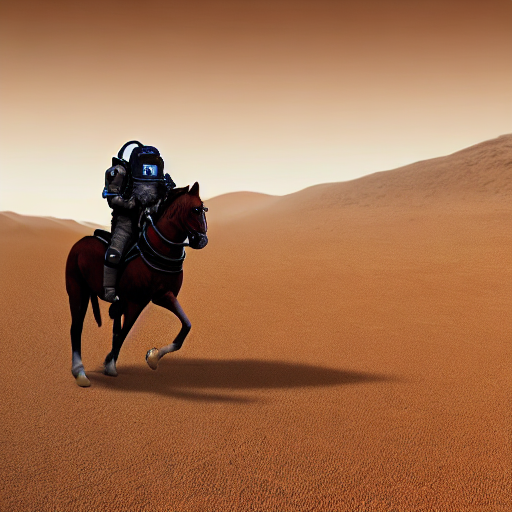Schedulers
Diffusion pipelines are inherently a collection of diffusion models and schedulers that are partly independent from each other. This means that one is able to switch out parts of the pipeline to better customize a pipeline to one’s use case. The best example of this is the Schedulers.
Whereas diffusion models usually simply define the forward pass from noise to a less noisy sample, schedulers define the whole denoising process, i.e.:
- How many denoising steps?
- Stochastic or deterministic?
- What algorithm to use to find the denoised sample?
They can be quite complex and often define a trade-off between denoising speed and denoising quality. It is extremely difficult to measure quantitatively which scheduler works best for a given diffusion pipeline, so it is often recommended to simply try out which works best.
The following paragraphs show how to do so with the 🧨 Diffusers library.
Load pipeline
Let’s start by loading the runwayml/stable-diffusion-v1-5 model in the DiffusionPipeline:
from huggingface_hub import login
from diffusers import DiffusionPipeline
import torch
login()
pipeline = DiffusionPipeline.from_pretrained(
"runwayml/stable-diffusion-v1-5", torch_dtype=torch.float16, use_safetensors=True
)Next, we move it to GPU:
pipeline.to("cuda")Access the scheduler
The scheduler is always one of the components of the pipeline and is usually called "scheduler".
So it can be accessed via the "scheduler" property.
pipeline.scheduler
Output:
PNDMScheduler {
"_class_name": "PNDMScheduler",
"_diffusers_version": "0.21.4",
"beta_end": 0.012,
"beta_schedule": "scaled_linear",
"beta_start": 0.00085,
"clip_sample": false,
"num_train_timesteps": 1000,
"set_alpha_to_one": false,
"skip_prk_steps": true,
"steps_offset": 1,
"timestep_spacing": "leading",
"trained_betas": null
}We can see that the scheduler is of type PNDMScheduler. Cool, now let’s compare the scheduler in its performance to other schedulers. First we define a prompt on which we will test all the different schedulers:
prompt = "A photograph of an astronaut riding a horse on Mars, high resolution, high definition."Next, we create a generator from a random seed that will ensure that we can generate similar images as well as run the pipeline:
generator = torch.Generator(device="cuda").manual_seed(8)
image = pipeline(prompt, generator=generator).images[0]
image

Changing the scheduler
Now we show how easy it is to change the scheduler of a pipeline. Every scheduler has a property compatibles
which defines all compatible schedulers. You can take a look at all available, compatible schedulers for the Stable Diffusion pipeline as follows.
pipeline.scheduler.compatibles
Output:
[diffusers.utils.dummy_torch_and_torchsde_objects.DPMSolverSDEScheduler,
diffusers.schedulers.scheduling_euler_discrete.EulerDiscreteScheduler,
diffusers.schedulers.scheduling_lms_discrete.LMSDiscreteScheduler,
diffusers.schedulers.scheduling_ddim.DDIMScheduler,
diffusers.schedulers.scheduling_ddpm.DDPMScheduler,
diffusers.schedulers.scheduling_heun_discrete.HeunDiscreteScheduler,
diffusers.schedulers.scheduling_dpmsolver_multistep.DPMSolverMultistepScheduler,
diffusers.schedulers.scheduling_deis_multistep.DEISMultistepScheduler,
diffusers.schedulers.scheduling_pndm.PNDMScheduler,
diffusers.schedulers.scheduling_euler_ancestral_discrete.EulerAncestralDiscreteScheduler,
diffusers.schedulers.scheduling_unipc_multistep.UniPCMultistepScheduler,
diffusers.schedulers.scheduling_k_dpm_2_discrete.KDPM2DiscreteScheduler,
diffusers.schedulers.scheduling_dpmsolver_singlestep.DPMSolverSinglestepScheduler,
diffusers.schedulers.scheduling_k_dpm_2_ancestral_discrete.KDPM2AncestralDiscreteScheduler]Cool, lots of schedulers to look at. Feel free to have a look at their respective class definitions:
- EulerDiscreteScheduler,
- LMSDiscreteScheduler,
- DDIMScheduler,
- DDPMScheduler,
- HeunDiscreteScheduler,
- DPMSolverMultistepScheduler,
- DEISMultistepScheduler,
- PNDMScheduler,
- EulerAncestralDiscreteScheduler,
- UniPCMultistepScheduler,
- KDPM2DiscreteScheduler,
- DPMSolverSinglestepScheduler,
- KDPM2AncestralDiscreteScheduler.
We will now compare the input prompt with all other schedulers. To change the scheduler of the pipeline you can make use of the
convenient config property in combination with the from_config() function.
pipeline.scheduler.config
returns a dictionary of the configuration of the scheduler:
Output:
FrozenDict([('num_train_timesteps', 1000),
('beta_start', 0.00085),
('beta_end', 0.012),
('beta_schedule', 'scaled_linear'),
('trained_betas', None),
('skip_prk_steps', True),
('set_alpha_to_one', False),
('prediction_type', 'epsilon'),
('timestep_spacing', 'leading'),
('steps_offset', 1),
('_use_default_values', ['timestep_spacing', 'prediction_type']),
('_class_name', 'PNDMScheduler'),
('_diffusers_version', '0.21.4'),
('clip_sample', False)])This configuration can then be used to instantiate a scheduler of a different class that is compatible with the pipeline. Here, we change the scheduler to the DDIMScheduler.
from diffusers import DDIMScheduler
pipeline.scheduler = DDIMScheduler.from_config(pipeline.scheduler.config)Cool, now we can run the pipeline again to compare the generation quality.
generator = torch.Generator(device="cuda").manual_seed(8)
image = pipeline(prompt, generator=generator).images[0]
image

If you are a JAX/Flax user, please check this section instead.
Compare schedulers
So far we have tried running the stable diffusion pipeline with two schedulers: PNDMScheduler and DDIMScheduler. A number of better schedulers have been released that can be run with much fewer steps; let’s compare them here:
LMSDiscreteScheduler usually leads to better results:
from diffusers import LMSDiscreteScheduler
pipeline.scheduler = LMSDiscreteScheduler.from_config(pipeline.scheduler.config)
generator = torch.Generator(device="cuda").manual_seed(8)
image = pipeline(prompt, generator=generator).images[0]
image

EulerDiscreteScheduler and EulerAncestralDiscreteScheduler can generate high quality results with as little as 30 steps.
from diffusers import EulerDiscreteScheduler
pipeline.scheduler = EulerDiscreteScheduler.from_config(pipeline.scheduler.config)
generator = torch.Generator(device="cuda").manual_seed(8)
image = pipeline(prompt, generator=generator, num_inference_steps=30).images[0]
image

and:
from diffusers import EulerAncestralDiscreteScheduler
pipeline.scheduler = EulerAncestralDiscreteScheduler.from_config(pipeline.scheduler.config)
generator = torch.Generator(device="cuda").manual_seed(8)
image = pipeline(prompt, generator=generator, num_inference_steps=30).images[0]
image

DPMSolverMultistepScheduler gives a reasonable speed/quality trade-off and can be run with as little as 20 steps.
from diffusers import DPMSolverMultistepScheduler
pipeline.scheduler = DPMSolverMultistepScheduler.from_config(pipeline.scheduler.config)
generator = torch.Generator(device="cuda").manual_seed(8)
image = pipeline(prompt, generator=generator, num_inference_steps=20).images[0]
image

As you can see, most images look very similar and are arguably of very similar quality. It often really depends on the specific use case which scheduler to choose. A good approach is always to run multiple different schedulers to compare results.
Changing the Scheduler in Flax
If you are a JAX/Flax user, you can also change the default pipeline scheduler. This is a complete example of how to run inference using the Flax Stable Diffusion pipeline and the super-fast DPM-Solver++ scheduler:
import jax
import numpy as np
from flax.jax_utils import replicate
from flax.training.common_utils import shard
from diffusers import FlaxStableDiffusionPipeline, FlaxDPMSolverMultistepScheduler
model_id = "runwayml/stable-diffusion-v1-5"
scheduler, scheduler_state = FlaxDPMSolverMultistepScheduler.from_pretrained(
model_id,
subfolder="scheduler"
)
pipeline, params = FlaxStableDiffusionPipeline.from_pretrained(
model_id,
scheduler=scheduler,
revision="bf16",
dtype=jax.numpy.bfloat16,
)
params["scheduler"] = scheduler_state
# Generate 1 image per parallel device (8 on TPUv2-8 or TPUv3-8)
prompt = "a photo of an astronaut riding a horse on mars"
num_samples = jax.device_count()
prompt_ids = pipeline.prepare_inputs([prompt] * num_samples)
prng_seed = jax.random.PRNGKey(0)
num_inference_steps = 25
# shard inputs and rng
params = replicate(params)
prng_seed = jax.random.split(prng_seed, jax.device_count())
prompt_ids = shard(prompt_ids)
images = pipeline(prompt_ids, params, prng_seed, num_inference_steps, jit=True).images
images = pipeline.numpy_to_pil(np.asarray(images.reshape((num_samples,) + images.shape[-3:])))The following Flax schedulers are not yet compatible with the Flax Stable Diffusion Pipeline:
FlaxLMSDiscreteSchedulerFlaxDDPMScheduler